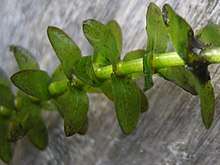Elodea
Elodea is a genus of 6 species of aquatic plants often called the waterweeds described as a genus in 1803. Classified in the frog’s-bit family (Hydrocharitaceae), Elodea is native to the Americas[1] and is also widely used as aquarium vegetation and laboratory demonstrations of cellular activities. It lives in fresh water.[3] An older name for this genus is Anacharis, which serves as a common name in North America.[4]
| Elodea | |
|---|---|
 | |
| Elodea canadensis foliage detail | |
| Scientific classification | |
| Kingdom: | Plantae |
| Clade: | Tracheophytes |
| Clade: | Angiosperms |
| Clade: | Monocots |
| Order: | Alismatales |
| Family: | Hydrocharitaceae |
| Subfamily: | Anacharioideae |
| Genus: | Elodea Michx. 1803 not J. St.-Hil. 1805 (Clusiaceae) nor Rich. |
| Synonyms[1] | |
| |
The introduction of some species of Elodea into waterways in parts of Europe, Australia, Africa, Asia, and New Zealand has created a significant problem and it is now considered a noxious weed in these areas.
Elodea canadensis, sometimes called American or Canadian water weed or pond weed, is widely known as the generic water weed. The use of these names causes it to be confused with similar-looking plants, like Brazilian elodea (Egeria densa) or hydrilla (Hydrilla verticillata). American water weed is an attractive aquarium plant and is a good substitute for Brazilian elodea. It can be used for science experiments in classrooms demonstrating how plants use carbon dioxide with the usage of bromothymol blue.
The American water weed lives entirely underwater with the exception of small white flowers which bloom at the surface and are attached to the plant by delicate stalks. It produces winter buds from the stem tips that overwinter on the lake bottom. It also often overwinters as an evergreen plant in mild climates. In the Autumn, leafy stalks will detach from the parent plant, float away, root, and start new plants. This is the American water weed's most important method of spreading, while seed production plays a relatively minor role.[5]
Silty sediments and water rich in nutrients favor the growth of American water weed in nutrient-rich lakes. However, the plants will grow in a wide range of conditions, from very shallow to deep water, and in many sediment types. It can even continue to grow uprooted, as floating fragments. It is found throughout temperate North America, where it is one of the most common aquatic plants.[5]
American water weed is an important part of lake ecosystems. It provides good habitat for many aquatic invertebrates and cover for young fish and amphibians. Waterfowl, especially ducks, as well as beaver, muskrat and aquatic turtles eat this plant. It is also of economic importance as an attractive and easy to keep aquarium plant, although in the states of Alabama, New Hampshire, New York, South Carolina, and Washington it has been deemed an invasive species and is illegal to sell.[6]
- Elodea bifoliata H.St.John - Canada (AB, SK), W United States (OR + CA to NM + MN)
- Elodea callitrichoides (Rich.) Casp. - Argentina, Uruguay
- Elodea canadensis Michx. - most of United States + Canada
- Elodea granatensis Humb. & Bonpl. - much of South America
- Elodea nuttallii (Planch.) H.St.John - much of United States + Canada
- Elodea potamogeton (Bertero) Espinosa - Chile, Peru, Bolivia, Ecuador
Chemical control
Chemical methods are ineffective in eradicating Elodea – at best they only slow growth for a season or two.[8] As Elodea spreads into new ecosystems, it experiences rapid growth for 5–6 years and then slows as soil nutrients are used up.[9] Elodea is threatening aquatic environments across Europe.[10] Chemicals may be used in places that cause undue economic concerns, but very few aquatic herbicides are registered for aquatic use in the EU. Fluridone, the most commonly used aquatic herbicide is highly effective against Hydrilla, but only marginally effective against Elodea, especially at lower use rates.[11][12][13]
See also
- Stormy Lake (Alaska) a lake where Fluridone was successfully used to eliminate elodea
References
- "World Checklist of Selected Plant Families: Royal Botanic Gardens, Kew". apps.kew.org. Retrieved 2017-01-31.
- Tropicos, search for Serpicula
- Luteyn, J. L. 1999. Páramos, a checklist of plant diversity, geographical distribution, and botanical literature. Memoirs of The New York Botanical Garden 84: viii–xv, 1–278
- "Elodea in Flora of North America @ efloras.org". www.efloras.org. Retrieved 2017-01-31.
- "Plants Profile for Elodea (waterweed)". plants.usda.gov. Retrieved 2017-01-31.
- Elodea canadensis details Archived 2009-08-20 at the Wayback Machine from Pond Conservation website, a UK organisation
- Biota of North America Program 2013 county distribution maps
- "Efficacy of Fluridone, Penoxsulam, and Bispyribac-sodium on Variable-leaf Milfoil". ResearchGate. Retrieved 2015-08-26.
- Thiébaut, Gabrielle (2005-09-01). "Does competition for phosphate supply explain the invasion pattern of Elodea species?". Water Research. 39 (14): 3385–3393. doi:10.1016/j.watres.2005.05.036. ISSN 0043-1354. PMID 16026814.
- Lambertini, Carla; Riis, Tenna; Olesen, Birgit; Clayton, John S; Sorrell, Brian K; Brix, Hans (2010-06-18). "Genetic diversity in three invasive clonal aquatic species in New Zealand". BMC Genetics. 11: 52. doi:10.1186/1471-2156-11-52. ISSN 1471-2156. PMC 2902404. PMID 20565861.
- Arias, Renée S.; Netherland, Michael D.; Scheffler, Brian E.; Puri, Atul; Dayan, Franck E. (2005-03-01). "Molecular evolution of herbicide resistance to phytoene desaturase inhibitors in Hydrilla verticillata and its potential use to generate herbicide-resistant crops". Pest Management Science. 61 (3): 258–268. doi:10.1002/ps.1022. ISSN 1526-498X. PMID 15668922.
- Michel, Albrecht; Arias, Renee S.; Scheffler, Brian E.; Duke, Stephen O.; Netherland, Michael; Dayan, Franck E. (2004-10-01). "Somatic mutation-mediated evolution of herbicide resistance in the nonindigenous invasive plant hydrilla (Hydrilla verticillata)". Molecular Ecology. 13 (10): 3229–3237. doi:10.1111/j.1365-294X.2004.02280.x. ISSN 0962-1083. PMID 15367135.
- Sepro, Corp. "SONAR H4C Label" (PDF). Sonar H4C Aquatic Herbicide. Sepro.
External links

- Jepson Manual Treatment